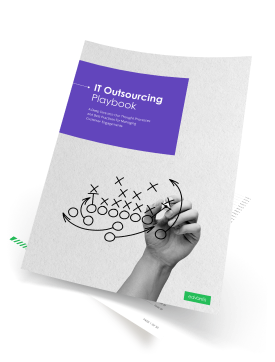Your product is getting more traction. And now, you want to add a new system component, migrate to the cloud, or shift maintenance operations to an outsourcing partner.
In every case, you need more people on board. And qualified engineering talent takes time to come by.
But even if you’ve already found and hired the team, you still need to ensure that your new task force understands your project’s operational and technical intricacies. Yet, scaling engineering teams is not as straightforward as it may seem.
What Does It Mean to Scale a Team?
Team scaling means getting more people (or teams) involved in a project, onboarding them, and adjusting operational processes to accommodate the increased workload.
In IT outsourcing, scaling can occur in three ways:
- Transition from Staff Augmentation to a Managed Team service model. This requires operational preparations since your vendor will assume partial or complete responsibility for team management.
- Expansion of your existing managed team. This approach has its limits: as a team gets too big, it is harder to manage.
- New unit(s). This option requires more operational preparation.
Although scaling is ultimately about expanding the team(s), it does not only imply linear growth:
Yes, scaling is a process of mostly ups, but there are also occasional downs. One of the main reasons for this is the hiring/retention dynamics. While new people join, others may leave your project (after doing their part).
Then there’s also project dynamics: different stages of development require different numbers of people. As development is in full swing, you need more specialists. When the project transitions to maintenance — you require fewer.
As a result, the scaling process will more likely look like this:
The speed and consistency of team scaling are challenging to predict because outside factors (state of the hiring market) influence the results. However, you can downplay those impacts by planning your scaling activities.
How Do You Initiate The Engineering Team Scaling Process?
In IT outsourcing, you can’t scale up a team on command — both you and the vendor must operationally prepare to hire and onboard new people.
Because extra prep is required, you should always inform the vendor about your need to scale software development teams in advance. You and your partner must adjust their operations to begin the recruitment process, source talent, and prepare an onboarding plan. All of these steps take time. Thus, the sooner you inform the vendor — the more likely they are to find people in time.
When Should You Start The Conversation About Scaling Teams?
The suitable timeframes for doing so comes at these project stages:
- At the beginning of the engagement (“We will need a 5-person team right now, but want to add more specialists in the future”).
- During yearly planning sessions (“We increased the revenue this year, and in the next one, we will be able to hire more people”).
- If the decision was factor-driven — as soon as possible (“We completed an audit of our operations last week, and we will need at least five more people to properly maintain them”).
Keeping your vendor aware of your plans proactively is also necessary since scaling doesn’t happen overnight. The process is not fast, especially considering today’s IT hiring market. For instance, 64% of business leaders already report that talent shortage is the most significant barrier to adopting new technologies. With such constrained talent availability and the heated state of IT staff augmentation marketing, hiring people with the right expertise will take time.
Ultimately, the scaling rate depends on the number of candidates and the uniqueness of their skill sets. The more people and the more particular skills, the longer it will take to hire them.
Still, you can move along with scaling quicker and smoother: the key is extensive preparation and a good alignment of plans with your vendor.
Getting Ready: Steps to Take and Decisions to Make Before Scaling an Outsourcing Team
Pre-scaling preparation begins with creating an overall vision, refining it with your outsourcing partner, and converting the vision into measurable goals.
To achieve this, you must proactively communicate with the vendor and provide constant feedback. Without it, you both risk working at cross purposes, which may lead to failure or at least cause long delays in finding the right people.
Below are steps you can take to gather all the information you need to refine your vision and make better decisions about the forthcoming scaling:
- Decide on the scaling approach: Do you need to extend an existing team or add an entirely new one?
- Identify the trigger: What prompts you to scale? What is your need for scaling?
- Define your end goal: What milestones should you be able to meet when you have more people onboard?
- Formalize your project requirements: Is it complex? Does it involve new expertise? Or is it backing up the existing one?
- Decide upon the team(s) size: What’s the approximate number of people you need to involve?
- List candidates’ requirements: What should their level of experience, skill sets, and education be?
- Define their responsibilities: What will the newcomers have to do on the project?
- Suggest the approximate deadline: When would you need the new people to start working? How much time do you have for onboarding?
- Define the scaling speed: At which pace do you expect the team to grow? Why do you need it to grow so fast/slow?
You don’t have to go through the steps mentioned alone — your vendor can help you with informed recommendations. After all, an outsourcing relationship is a partnership.
With vast experience in building teams and a thorough understanding of your business context, your vendor can help you fill in the gaps of the missing information, from determining the optimal number of specialists to selecting the optimal technology stack for the project.
But even if you went through these steps alone and think you have every detail nailed down, refining the input with your vendor is still a good idea. Use your outsourcing partner as a “sounding board” to verify your scaling plans are realistic.
To sum up, your vendor needs to have all the above information clear and refined early on. Otherwise, they can’t guarantee high-performance rates in terms of scalability.
But good preparation is only half the battle. The next step is looking for people and onboarding them on the project.
The Team Scaling Process Has Begun. What’s Next?
Following the preparation phase, you don’t simply hand over the rest to your outsourcing vendor and then demand results later. Even though recruitment processes are on your partner’s side, your vendor will need constant feedback concerning the candidates.
You are both involved in scaling from beginning to end but at different levels. Below are three processes that will require your attention as a client:
Ensure Your Vision and Goals are Attainable
Ensure that every step of the scaling process leads to what you have envisioned. Scaling will not happen in a vacuum, and many obstacles can arise, like issues with talent availability or budget constraints.
From time to time, it’s OK to ask yourself if your decisions are leading to the desired results or whether your vision is attainable. Answering “no” to either of these questions means you need to make some changes, either to how you scale or to your end goal.
Co-Create an Onboarding Plan With Your Vendor
A well-designed onboarding plan helps new members understand the overall project goals. It also assists them with getting up to speed on the past work done, standard workflows, and critical success metrics.
Typically, the onboarding process begins with introducing newcomers to team members and ends with them receiving access to collaboration tools.
But don’t forget: with outsourcing, you must onboard people remotely. Here’s how to do so effectively:
- Configure required identity management: For example, ensure that when new employees log in to the PM tool, they can immediately access all the relevant project information without searching manually.
- Ensure on-the-job training: This will enable the hired professionals to take on their responsibilities faster and better understand the tasks. But also create written instructions: When newcomers forget something, they will have a place to go back to.
- Socialize the newcomers: Introduce the team, describe the project’s history, what you’ve done so far, etc. Explain the team hierarchy and provide an overview of the communication and reporting schedule.
- Give them time: Onboarding extends for more than just the first day of the first week. Your new employees will need more than one day to accommodate and learn everything they need to start working.
Don’t worry: you are not alone in this. Your vendor will also create an onboarding plan on their side. They must prepare resources because they are responsible for the team’s administrative support. Also, they must ensure enough workspace, laptops, and other perks like welcome boxes, merch, etc., are available.
The onboarding process determines how well new employees integrate into the company and plays a vital role in talent retention. Employees who feel appreciated at every step are more likely to stay.
Communicate Regularly and Provide Feedback
Scaling teams does not only mean you hire more people. It also results in scaling your relationship with a vendor. So, you will need to be more deliberate about your communication.
A strong communication cadence and a culture of feedback help:
- Achieve better alignment at every scaling step
- Address rough patches early on
- Refine your vision and scaling pace
- Ensure optimal candidate fits (especially if you co-manage)
- Your partner addresses the shifts in your needs (e.g., due to budget constraints)
Every communication session with your vendor will be another brick in building mutual trust, which will result in better scaling in the future.
Case Study: Doc Cirrus Team Scaling
IT outsourcing, treated as a partnership, is a proven way to expand your IT function capacity. It’s a step that helps you pursue more ambitious projects and accelerate time-to-market for your products. Edvantis & Doc Cirrus partnership is an excellent example of scaling your team with an IT outsourcing vendor.
Doc Cirrus is a health tech vendor delivering innovative solutions to the German healthcare market. Edvantis has been initially supporting the company as a staff augmentation partner. During that time, Doc Cirrus entered the Swiss HealthTech market, expanded the core product’s functionality, and grew its customer base.
As the demand for the company’s software products increased, Doc Cirrus decided to accelerate new feature development for its core product – inSuite. The team wanted to transform inSuite into an ecosystem of new competitive eHealth apps (like an AppStore for HealthTech).
Doc Cirrus faced IT talent shortages and decided to scale their team with Edvantis HealthTech specialists. The client communicated their plans early so Edvantis could begin increasing the team headcount without extra onboarding complexities (since some Edvantis specialists have already integrated into Doc Cirrus’ internal workflows). With a scaled team and an expanded partnership, we introduced several features and improvements and helped Doc Cirrus attract new customers to their ecosystem.
“We needed to flexibly grow our software development team and have had great success with Edvantis providing a fixed near-shore team of highly skilled developers. Some key product components are developed by Edvantis”
Ronald Wertlen, Head of Software Development at Doc Cirrus
To Conclude
Scaling is a dynamic process. For it to work, you need to have put down some groundwork —understand why you need to scale, what you hope to gain from it, and when you anticipate the results. And then, after you communicate this info with your outsourcing partner, the scaling process begins — bringing new people and new opportunities into your project!
If you’d like to learn more about different service models and best practices in scaling outsourced teams, contact Edvantis for a free workshop session.


